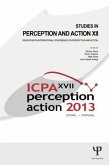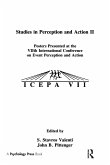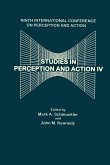Studies in Reflecting Abstraction
Herausgeber: Campell, Robert L.
Studies in Reflecting Abstraction
Herausgeber: Campell, Robert L.
- Broschiertes Buch
- Merkliste
- Auf die Merkliste
- Bewerten Bewerten
- Teilen
- Produkt teilen
- Produkterinnerung
- Produkterinnerung
Rich with empirical research on reflecting abstraction at work in the thinking of 4 - 12 year olds, the studies in this volume examine its role in many contexts of cognitive development.
Andere Kunden interessierten sich auch für
![Studies in Perception and Action XII Studies in Perception and Action XII]() Studies in Perception and Action XII96,99 €
Studies in Perception and Action XII96,99 €![Studies in Perception and Action XIII Studies in Perception and Action XIII]() Studies in Perception and Action XIII97,99 €
Studies in Perception and Action XIII97,99 €![Studies on the History of Behavior Studies on the History of Behavior]() L. S. VygotskyStudies on the History of Behavior64,99 €
L. S. VygotskyStudies on the History of Behavior64,99 €![Studies in Perception and Action II Studies in Perception and Action II]() Studies in Perception and Action II137,99 €
Studies in Perception and Action II137,99 €![Studies in Perception and Action IV Studies in Perception and Action IV]() Studies in Perception and Action IV65,99 €
Studies in Perception and Action IV65,99 €![Studies in Perception and Action III Studies in Perception and Action III]() Studies in Perception and Action III52,99 €
Studies in Perception and Action III52,99 €![Sensation Seeking Sensation Seeking]() Marvin ZuckermanSensation Seeking72,99 €
Marvin ZuckermanSensation Seeking72,99 €-
-
-
Rich with empirical research on reflecting abstraction at work in the thinking of 4 - 12 year olds, the studies in this volume examine its role in many contexts of cognitive development.
Produktdetails
- Produktdetails
- Verlag: Psychology Press
- Seitenzahl: 350
- Erscheinungstermin: 21. August 2015
- Englisch
- Abmessung: 234mm x 156mm x 19mm
- Gewicht: 532g
- ISBN-13: 9781138877375
- ISBN-10: 1138877379
- Artikelnr.: 42788494
- Herstellerkennzeichnung
- Libri GmbH
- Europaallee 1
- 36244 Bad Hersfeld
- gpsr@libri.de
- Verlag: Psychology Press
- Seitenzahl: 350
- Erscheinungstermin: 21. August 2015
- Englisch
- Abmessung: 234mm x 156mm x 19mm
- Gewicht: 532g
- ISBN-13: 9781138877375
- ISBN-10: 1138877379
- Artikelnr.: 42788494
- Herstellerkennzeichnung
- Libri GmbH
- Europaallee 1
- 36244 Bad Hersfeld
- gpsr@libri.de
Jean Piaget. Edited and translated by Robert L. Campell
Introduction: Reflecting Abstraction in Context (Robert L. Campbell) Part
1: The Abstraction of Logico-arithmetic Relations. Preface:
Logico-arithmetical or Algebraic Abstraction. 1. Abstraction,
Differentiation, and Integration in the Use of Elementary Arithmetic
Operations. 2. The Construction of Common Multiples. 3. The Inversion of
Arithmetic Operations. 4. Abstraction Generalization During Transfers of
Units. 5. Problems of Class Inclusion and Logical Implication. 7. The Form
and Logical Implication. 8. The Formation of Analogies. 9. From Concrete
Forms of the Klein Group to the INRC Group. Part 2: The Abstraction of
Order. 9. Additive and Exponential Series. 10. Conditions on Reading off
Complex Additive Series. 11. Ordering Practical Activity. 12. Changes in
Ordering or Necessary Backtracking. Conclusion of Part Two. Part 3: The
Abstraction of Spatial Relationships. 13. Relations Between the Surface
Area and the Perimeter of Rectangles. 14. The Movements of a Suspended
Projectile. 15. Diagonals. 16. The Displacement of a Reference Point in a
System of Cyclic Movements. 17. Abstraction from Displacements and from
their Coordinates. 18. Rotations and Translations. 19. The Rotation of a
Bar Around a Pivot During the Sensorimotor Period. Conclusion of Part 3.
General Conclusions: I. Projection. II. The Creation of Novelties Specific
to Reflecting Abstraction. III. Equilibration, the Source of Noveltles, and
Relationships Between the Intentions and Extensions of Structures. IV.
Empirical and Reflecting Abstraction.
1: The Abstraction of Logico-arithmetic Relations. Preface:
Logico-arithmetical or Algebraic Abstraction. 1. Abstraction,
Differentiation, and Integration in the Use of Elementary Arithmetic
Operations. 2. The Construction of Common Multiples. 3. The Inversion of
Arithmetic Operations. 4. Abstraction Generalization During Transfers of
Units. 5. Problems of Class Inclusion and Logical Implication. 7. The Form
and Logical Implication. 8. The Formation of Analogies. 9. From Concrete
Forms of the Klein Group to the INRC Group. Part 2: The Abstraction of
Order. 9. Additive and Exponential Series. 10. Conditions on Reading off
Complex Additive Series. 11. Ordering Practical Activity. 12. Changes in
Ordering or Necessary Backtracking. Conclusion of Part Two. Part 3: The
Abstraction of Spatial Relationships. 13. Relations Between the Surface
Area and the Perimeter of Rectangles. 14. The Movements of a Suspended
Projectile. 15. Diagonals. 16. The Displacement of a Reference Point in a
System of Cyclic Movements. 17. Abstraction from Displacements and from
their Coordinates. 18. Rotations and Translations. 19. The Rotation of a
Bar Around a Pivot During the Sensorimotor Period. Conclusion of Part 3.
General Conclusions: I. Projection. II. The Creation of Novelties Specific
to Reflecting Abstraction. III. Equilibration, the Source of Noveltles, and
Relationships Between the Intentions and Extensions of Structures. IV.
Empirical and Reflecting Abstraction.
Introduction: Reflecting Abstraction in Context (Robert L. Campbell) Part
1: The Abstraction of Logico-arithmetic Relations. Preface:
Logico-arithmetical or Algebraic Abstraction. 1. Abstraction,
Differentiation, and Integration in the Use of Elementary Arithmetic
Operations. 2. The Construction of Common Multiples. 3. The Inversion of
Arithmetic Operations. 4. Abstraction Generalization During Transfers of
Units. 5. Problems of Class Inclusion and Logical Implication. 7. The Form
and Logical Implication. 8. The Formation of Analogies. 9. From Concrete
Forms of the Klein Group to the INRC Group. Part 2: The Abstraction of
Order. 9. Additive and Exponential Series. 10. Conditions on Reading off
Complex Additive Series. 11. Ordering Practical Activity. 12. Changes in
Ordering or Necessary Backtracking. Conclusion of Part Two. Part 3: The
Abstraction of Spatial Relationships. 13. Relations Between the Surface
Area and the Perimeter of Rectangles. 14. The Movements of a Suspended
Projectile. 15. Diagonals. 16. The Displacement of a Reference Point in a
System of Cyclic Movements. 17. Abstraction from Displacements and from
their Coordinates. 18. Rotations and Translations. 19. The Rotation of a
Bar Around a Pivot During the Sensorimotor Period. Conclusion of Part 3.
General Conclusions: I. Projection. II. The Creation of Novelties Specific
to Reflecting Abstraction. III. Equilibration, the Source of Noveltles, and
Relationships Between the Intentions and Extensions of Structures. IV.
Empirical and Reflecting Abstraction.
1: The Abstraction of Logico-arithmetic Relations. Preface:
Logico-arithmetical or Algebraic Abstraction. 1. Abstraction,
Differentiation, and Integration in the Use of Elementary Arithmetic
Operations. 2. The Construction of Common Multiples. 3. The Inversion of
Arithmetic Operations. 4. Abstraction Generalization During Transfers of
Units. 5. Problems of Class Inclusion and Logical Implication. 7. The Form
and Logical Implication. 8. The Formation of Analogies. 9. From Concrete
Forms of the Klein Group to the INRC Group. Part 2: The Abstraction of
Order. 9. Additive and Exponential Series. 10. Conditions on Reading off
Complex Additive Series. 11. Ordering Practical Activity. 12. Changes in
Ordering or Necessary Backtracking. Conclusion of Part Two. Part 3: The
Abstraction of Spatial Relationships. 13. Relations Between the Surface
Area and the Perimeter of Rectangles. 14. The Movements of a Suspended
Projectile. 15. Diagonals. 16. The Displacement of a Reference Point in a
System of Cyclic Movements. 17. Abstraction from Displacements and from
their Coordinates. 18. Rotations and Translations. 19. The Rotation of a
Bar Around a Pivot During the Sensorimotor Period. Conclusion of Part 3.
General Conclusions: I. Projection. II. The Creation of Novelties Specific
to Reflecting Abstraction. III. Equilibration, the Source of Noveltles, and
Relationships Between the Intentions and Extensions of Structures. IV.
Empirical and Reflecting Abstraction.









